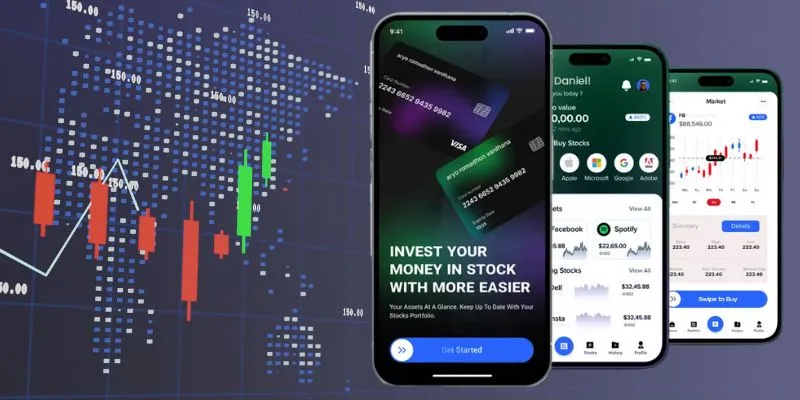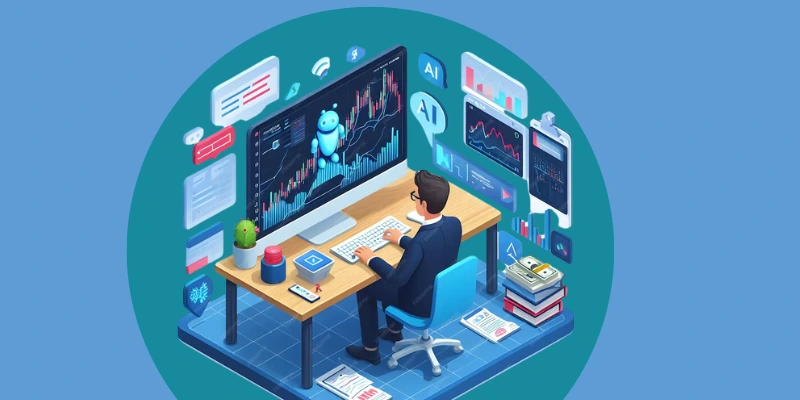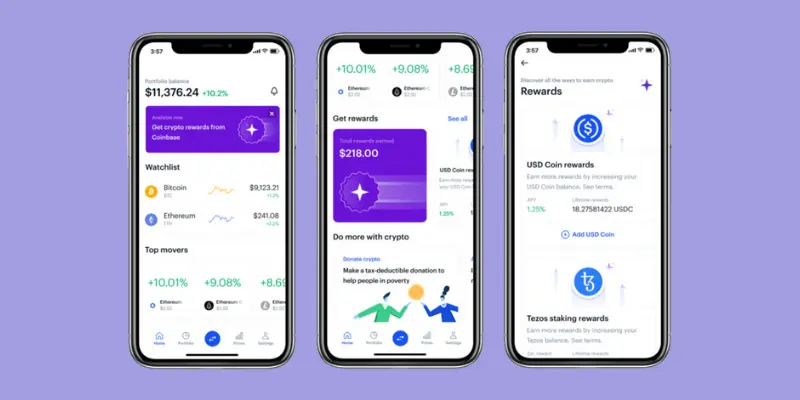The stock market serves as the cornerstone of our financial system and has become integral to both individual development and economic progress.
Traditional trading has evolved into platforms accessible via smartphone or laptop; developing stock trading apps for these platforms could prove highly lucrative for firms as more individuals engage with mobile trading compared with more conventional investing methods. On-demand trading App Development Services allow businesses to capitalize on this growing trend.
In this comprehensive guide, we'll outline how to develop an app for stock trading efficiently, safely and effortlessly. One key element of app creation is selecting suitable trading strategies and platforms which will form the core of your app.
What is the Stock Trading App?
Stock trading applications are applications for software that allow users to purchase and sell bonds, stocks, and other securities via their phones or personal computers. The apps offer real-time news, quotes, market research, and instruments for monitoring and managing portfolios. Many stock trading app development company provide educational tools and simulation trading platforms, allowing users to test their abilities without risking real cash.
Stock trading application development is designing and constructing an app for trading stocks. The process can be a mix of creating the user interface, connecting financial data feeds to the app and security features, and testing the application for reliability and user-friendliness.
The development of a stock trading application usually requires a group of hiring software developers, designers, and experts in finance working together to develop an efficient and easy-to-use product. At the end of this article, you'll know the basics of building your platform for trading stocks and help bring your ideas to fruition.
How to Build a Profitable Mobile Stock Trading App
.webp)
The following are the main elements involved in developing a trading platform. This is a greater detail of each stage:
Step 1: Create a Comprehensive Business Plan
-
Market Research:
This is the stage where you'll conduct a thorough research process to identify the intended market of your app, which includes the preferences and needs of the potential customers. This can help you pinpoint possible areas of differentiating your application.
-
Set Goals and Objectives:
The next step is to identify the app's primary goals and purposes, including increasing customer engagement, making money, and establishing brand recognition.
-
Identify Competitors:
It is crucial to study your competition and understand how your app is positioned against other apps that trade stocks on the marketplace. This can help you determine your app's unique selling point and opportunities for improvement.
-
Create a Financial Projection:
This is where you'll develop a financial plan for your app that includes estimations of expenses, revenue, and profitability. This will allow you to understand the app's possibility of profitability and assist in making informed choices about the monetization plan and business model.
Step 2: Design the App
-
Choose A Platform:
As a mobile and web developer, choosing the right platform, such as iOS, Android, or the web, is essential. The app you create will be designed to work on that platform. The exact target market will depend on the market you intend to target and the resources available to you.
-
Develop User Interface:
Please create an easy-to-use interface that is simple to navigate. The interface should have an intuitive layout, clear calls to action, and attractive graphics.
-
Create App Features:
Choose the features and functions the market you intend to target is likely to value. These could be tools or sources for trading stocks, including charts, research, and technical analysis. It's important to find an equilibrium between offering an extensive set of options and avoiding feature overload, which can make the software complicated to navigate.
Step 3: Testing and Launch
-
Beta Testing:
Prior to launching the app, it is essential to conduct beta tests to collect comments and identify any problems that require attention. Beta testing involves releasing an unrestricted version of the application to a small group of test users who will offer feedback and discuss any issues they have encountered.
-
Testing for Compliance and Security:
If the app you use handles sensitive financial information or transactions, it's important to verify its security and ensure compliance with any applicable standards of compliance.
-
Store Listing for Apps:
At this point, you'll have to publish your application on the appropriate marketplace (e.g., Apple App Store, Google Play Store) and then make it available to all customers.
Step 4: Market and Promote The App
-
App Store Optimization (ASO):
It involves optimizing your app's listings on the store's app to increase its visibility and boost downloads. Methods could include keyword optimization, ratings and reviews, and visually pleasing graphic designs.
-
Social Media Promotion:
Use social media platforms to market your application and interact with users who are interested in it. This could include creating content, running advertisements, or joining relevant groups.
-
Paid Advertising:
Think about running advertisements for paid traffic to a wider population and encouraging more application downloads. Google AdWords and Facebook Ads offer an efficient means of reaching specific demographics or interests.
Step 5: Monitor and Analyze User Behavior
-
Track User Engagement:
Analytics tools can help you track crucial metrics, such as the active number of users, the frequency of usage, and the amount of time users spend on the app. This helps you understand how users interact with the application and identify areas for improvement.
-
Identify Patterns and Trends:
Examine user information to find patterns and trends in user behavior. These could include changes in user demographics, usage patterns, and feedback.
-
Adjust App Features As Needed:
Based on the information gained by tracking user engagement and identifying trends and patterns, adjust the application's features depending on the need to enhance customer experience and boost engagement. This could include including new features, removing unneeded features, or altering existing functions.
Key Features of a Stock Trading App
Stock trading platforms offer many exciting options. Some of these include providing alerts and shares to users in exchange for them introducing someone else to the site or trading commission-free. These lucrative options have contributed to the need for developing a stock exchange mobile application. Over the last few years, there has been an increase in the recruitment of software for stock market developers.
General Features for eTrading App Development
-
Commission-Free Trading: Investment apps for the share market attract traders today by providing services like commission-free trading. With this option, a broker-dealer's income source is the interest on clients' uninvested money.
-
Giving away free shares: Another way an app that trades stocks offers its users rewards is to give the users free shares when they bring their friends and acquaintances into the app.
-
Sending useful alerts: One of the principal advantages of a share market application is that it sends out regular alerts concerning the state of the stock market. In the event of receiving these alerts Users can find out what stocks to invest in as well as which stocks to dispose of.
Admin Features for Stock Trading App Development
-
Register: After opening an app to invest in shares, users will find the button labeled login/sign-in. If the user is brand new to the app, another labeled button will appear.
-
Registration/Sign-up: App developers on mobiles should be aware of making the interface easy for users. Furthermore, this page contains not only the conditions and terms to use the mobile application for trading stocks but also the assurance that users' information is encrypted.
User Panel Features for Share Market Investment App
-
Personal profile: The profile interface includes all the needed information. From the person's name to preferences for language and photos, this section includes everything.
-
Graphs: Sometimes called trading functions, are among the essential functions of the shares market application relevant to users. This site provides live information regarding the market forms of charts and graphs. This helps the user determine the areas where they can assist them in growing their wealth.
-
Reports: Reports that analyze help the user track the progress they make in their smartphone app, which tracks the stock market. Share market investment applications are also known for regular updates to their customers with automatically generated reports.
-
Payment Options: Payment options are critical to stock trading and investment app development. Customers require this feature for buying and selling shares and stocks. One thing developers of apps for stock exchanges must remember is that they must think about a payment processor that protects user transactions and personal information.
Advanced features for a stock trading and investment app
-
Notifications via push notifications on sudden fluctuations in the market.
-
The share market app's newsfeed lets users be aware of the latest developments in the world of stocks.
-
Search engines so that users can access data or look up the company they wish to purchase shares and stocks for.
It must have instruments that assist in sorting and filtering the information.
What is the cost of constructing a Trading Platform?
The cost of development depends upon many variables, including an app's complexity, features, cloud services operating systems used, development timeframe, and location of the IT consultancy firm. When considering creating Trading Software Development Services and their costs, those should all be taken into consideration.
Development of Fintech apps can be a daunting task. Nevertheless, the app must always be user-friendly to get more customers to engage. To develop a trading app, the team you hire to create it would require between 6 and 12 months. The total costs range between $25,000 and $300,000. The price for application development will vary based on the available features and functions, as well as the overall degree of complexity of the app.
Benefits of Stock Trading App Development
Are You Thinking about Building a Stock Trading App development? There Are Benefits! In this article, we explore some advantages of developing an app for trading stocks and ways to hire developers. Stock Trading App Development Solutions provides all the tools and expertise to create successful and efficient trading platforms for their clients.
Accessibility and Convenience
One of the most significant advantages of app trading stocks is their accessibility. Customers can make trades anytime, anywhere, without physically being at the brokerage office or using an electronic device. This convenience level is vital in a rapidly paced environment where people are constantly moving. Using trading software makes it possible to monitor portfolios and trades and be informed about current market conditions in real-time market data.
Stock trading applications provide traders with current market information that is crucial to making informed decisions about trading. They integrate with a variety of news sources and financial markets for the latest information on stock prices, market news, and financial analysis. These real-time updates help traders capitalize on opportunities in the market and swiftly make decisions to maximize their earnings.
User-Friendly Interface
Modern trading applications for stocks are created with the user with user experience in the back of their minds. They have intuitive interfaces, making it effortless for experienced and novice traders to use the application.
Customers can swiftly execute trades and track their investment customizable hassle by offering features like one-click trading customized dashboards, customizable dashboards, and easily-to-read graphs. The right app design can dramatically improve user satisfaction and engagement.
Cost-Effective Trading
Traditional brokerage companies typically charge high fees and commissions. However, trading on stock applications usually has lower transaction fees, making trading much more affordable. Certain apps offer commission-free trading, which has been a massive attraction for new investors. Through lowering the barriers to entry the applications enable an increased number of investors to join the market for stocks.
Enhanced Security
Security is an essential factor when developing stock trading apps. These apps employ sophisticated encryption techniques to safeguard the privacy of users' financial and personal data. Options such as 2-factor authentication (2FA), biometric logins, and secured data storage mean that traders can make transactions with security, knowing that their data are safe from cyber-attacks.
Educational Resources
Many stock trading app development companies offer instructional resources for users to enhance their trading skills. They can provide videos, tutorials, webinars, and even videos that cover different trading and market analysis strategies. With these educational materials, applications can assist users in making better decisions and improving their trading skills as time passes.
Customizable Alerts and Notifications
Stock trading applications allow traders to create custom alarms and alerts for specific markets or stocks. This ensures that investors do not miss essential trading opportunities. It doesn't matter if it's a decline in the price, significant market movement, or information about an individual company; they will be aware of and respond quickly to any market fluctuations.
Portfolio Management
An effective portfolio management strategy is vital to a successful trade. Apps for trading stocks offer instruments that allow users to monitor their investment portfolios, evaluate their investments' performance, and make data-driven decisions. Performance charts, asset allocation analysis, and risk assessment tools help investors efficiently manage their portfolios and improve their investment strategies.
Integration with Banking Services
Numerous stock trading applications provide seamless integration with banks, which allows clients to transfer funds swiftly and effortlessly. This makes funding accounts for trading and taking profits easier. By providing easy and effective transactions, these apps increase the user's experience and make it more enjoyable.
Community and Social Trading
A few stock trading apps include social trading capabilities, which allow users to interact with other traders, share their insights, and share knowledge. These features help create a feeling of belonging and offer the opportunity for traders to acquire valuable information from experienced traders. Social trading may also involve the copy trade, in which traders are able to replicate trades made by experienced traders.
Advanced Trading Tools
If you are a seasoned trader, Stock trading applications offer sophisticated tools and features like technical analysis charts, algorithmic trading, and backtesting. The tools allow traders to use sophisticated strategies to improve their performance. With various functions that can be tailored to different levels of expertise, stock trading applications can be marketed to the needs of a wide range of people.
Competitive Advantage
In a highly competitive marketplace with much competition, having a professionally designed and feature-rich app for trading stocks will give you an essential competitive advantage. Companies that hire Stock Trading App developers skilled in creating innovative apps can differentiate themselves from their competitors. Through offering an exceptional trading experience, they will attract more clients and build a solid market position.
Scalability and Growth
The apps for trading stocks are highly adaptable, allowing developers to develop more features and capabilities if user numbers increase. The app's scalability ensures that it can be adapted to changing market trends and user demands. By constantly updating and enhancing the app, developers will be able to ensure that users are engaged and remain at the forefront of their industry.
Enhanced User Engagement
Gamification, interactive features like leaderboards, and rewards programs may increase satisfaction and retention. They make trading engaging and motivate customers to be actively involved with the trading platform. By keeping their users active, these apps help establish a long-lasting customer base and help increase long-term revenue.
Conclusion
Developing a stock trading application requires several critical actions, such as identifying the market's requirements, designing an easy-to-use interface, and developing and testing the application. It is crucial to think about the preferences and needs of the market you intend to target and find a compromise between offering a broad array of options and avoiding feature excess.
The expense of developing a stock trading application depends on several factors, such as the platform used, the functionality and features of the application, the degree of customization to the design, and the amount of time it takes to develop. Discussing your requirements and budget with a stock trading app development company is essential for a more exact cost estimate.












Share this blog